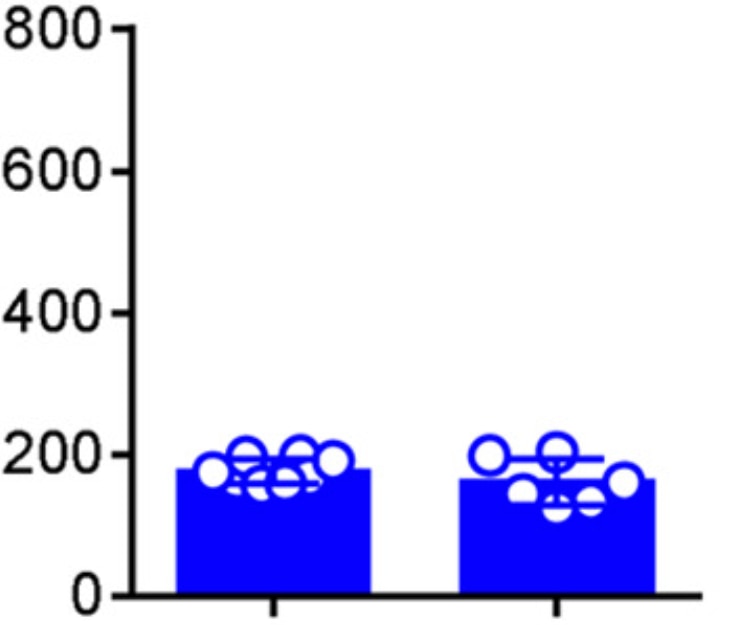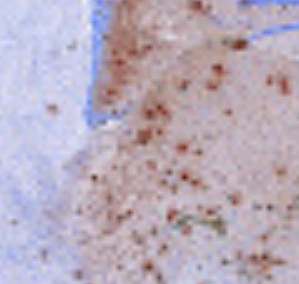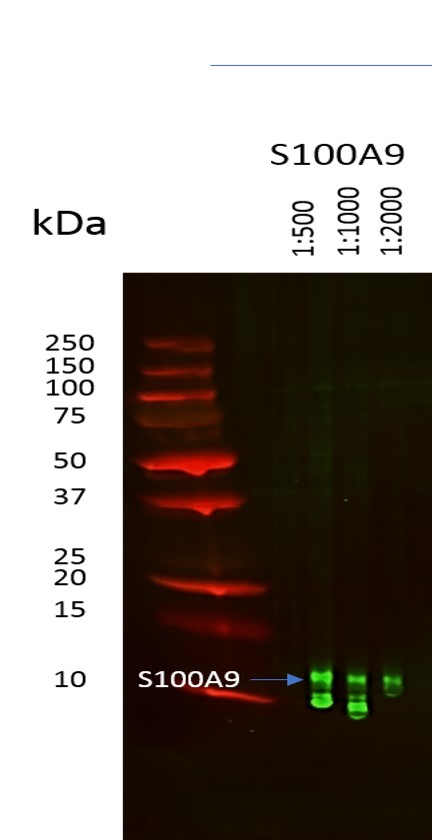Mouse S100A9 Antibody Summary
Ala2-Lys113
Accession # P31725
Applications
Please Note: Optimal dilutions should be determined by each laboratory for each application. General Protocols are available in the Technical Information section on our website.
Scientific Data
 View Larger
View Larger
Detection of Mouse S100A9 by Western Blot. Western blot shows lysate of mouse lung tissue. PVDF membrane was probed with 0.2 µg/mL of Goat Anti-Mouse S100A9 Antigen Affinity-purified Polyclonal Antibody (Catalog # AF2065) followed by HRP-conjugated Anti-Goat IgG Secondary Antibody (Catalog # HAF017). A specific band was detected for S100A9 at approximately 14 kDa (as indicated). This experiment was conducted under reducing conditions and using Immunoblot Buffer Group 1.
 View Larger
View Larger
S100A9 in XB2 Mouse Cell Line. S100A9 was detected in immersion fixed XB2 mouse teratoma keratinocyte cell line using 10 µg/mL Goat Anti-Mouse S100A9 Antigen Affinity-purified Polyclonal Antibody (Catalog # AF2065) for 3 hours at room temperature. Cells were stained with the NorthernLights™ 557-conjugated Anti-Goat IgG Secondary Antibody (red; NL001) and counte-rstained with DAPI (blue). View our protocol for Fluorescent ICC Staining of Cells on Coverslips.
 View Larger
View Larger
S100A9 in Mouse Splenocytes. S100A9 was detected in immersion fixed mouse splenocytes using Goat Anti-Mouse S100A9 Antigen Affinity-purified Polyclonal Antibody (Catalog # AF2065) at 5 µg/mL for 3 hours at room temperature. Cells were stained using the NorthernLights™ 557-conjugated Anti-Goat IgG Secondary Antibody (red; Catalog # NL001) and counterstained with DAPI (blue). Specific staining was localized to cell surfaces and cytoplasm. View our protocol for Fluorescent ICC Staining of Non-adherent Cells.
 View Larger
View Larger
S100A9 in Mouse Spleen. S100A9 was detected in perfusion fixed frozen sections of mouse spleen using Goat Anti-Mouse S100A9 Antigen Affinity-purified Polyclonal Antibody (Catalog # AF2065) at 0.3 µg/mL for 1 hour at room temperature followed by incubation with the Anti-Goat IgG VisUCyte™ HRP Polymer Antibody (VC004). Tissue was stained using DAB (brown) and counterstained with hematoxylin (blue). Specific staining was localized to cytoplasm in splenocytes. View our protocol for IHC Staining with VisUCyte HRP Polymer Detection Reagents.
 View Larger
View Larger
Detection of Mouse S100A9 by Simple Western™ Simple Western lane view shows lysates of mouse lung tissue and mouse spleen tissue, loaded at 0.2 mg/mL. A specific band was detected for S100A9 at approximately 20 kDa (as indicated) using 2 µg/mL of Goat Anti-Mouse S100A9 Antigen Affinity-purified Polyclonal Antibody (Catalog # AF2065) followed by 1:50 dilution of HRP-conjugated Anti-Goat IgG Secondary Antibody (Catalog # HAF109). This experiment was conducted under reducing conditions and using the 12-230 kDa separation system.
Reconstitution Calculator
Preparation and Storage
- 12 months from date of receipt, -20 to -70 °C as supplied.
- 1 month, 2 to 8 °C under sterile conditions after reconstitution.
- 6 months, -20 to -70 °C under sterile conditions after reconstitution.
Background: S100A9
S100A9, also known as calgranulin B, migration inhibitory factor-related protein 14 (MRP14), belongs to the S100 family of calcium binding proteins of the EF-hand type. It is highly expressed in myeloid cells and other cell types including keratinocytes, epithelial cells and endothelial cells. S100A9 is a cytosolic protein that can also be released into the extracellular milieu. It is associated with various inflammatory diseases.
Product Datasheets
Citations for Mouse S100A9 Antibody
R&D Systems personnel manually curate a database that contains references using R&D Systems products. The data collected includes not only links to publications in PubMed, but also provides information about sample types, species, and experimental conditions.
34
Citations: Showing 1 - 10
Filter your results:
Filter by:
-
Two independent modes of kidney stone suppression achieved by AIM/CD5L and KIM-1
Authors: Kyohei Matsuura, Natsumi Maehara, Aika Hirota, Ayaka Eguchi, Keisuke Yasuda, Kaori Taniguchi et al.
Communications Biology
-
Crisaborole Inhibits Itch and Pain by Preventing Neutrophil Infiltration in a Mouse Model of Atopic Dermatitis
Authors: Darya Pavlenko, Zeynep Todurga Todurga Seven, Lauren Bystrom, Anika Markan, Rebecca Verpile, Hirotake Ishida et al.
Acta Dermato-Venereologica
-
Enterically derived high-density lipoprotein restrains liver injury through the portal vein
Authors: Han Y, Onufer E, Huang L et al.
Science
-
Expression of factor V by resident macrophages boosts host defense in the peritoneal cavity
Authors: Nan Zhang, Rafael S. Czepielewski, Nicholas N. Jarjour, Emma C. Erlich, Ekaterina Esaulova, Brian T. Saunders et al.
Journal of Experimental Medicine
-
Tasquinimod modulates tumor-infiltrating myeloid cells and improves the antitumor immune response to PD-L1 blockade in bladder cancer
Authors: Jessica Nakhlé, Valérie Pierron, Anne-Laure Bauchet, Pascale Plas, Amath Thiongane, Florence Meyer-Losic et al.
OncoImmunology
-
S100a9 Protects Male Lupus-Prone NZBWF1 Mice From Disease Development
Authors: Laura M. Davison, Andres A. Alberto, Hardik A. Dand, Emma J. Keller, Madeline Patt, Ayesha Khan et al.
Frontiers in Immunology
-
Poly(ADP-ribose) polymerase 9 mediates early protection against Mycobacterium tuberculosis infection by regulating type I IFN production
Authors: Shyamala Thirunavukkarasu, Mushtaq Ahmed, Bruce A. Rosa, Mark Boothby, Sung Hoon Cho, Javier Rangel-Moreno et al.
Journal of Clinical Investigation
-
T cell-specific P2RX7 favors lung parenchymal CD4+ T cell accumulation in response to severe lung infections
Authors: Santiago-Carvalho, I;Almeida-Santos, G;Macedo, BG;Barbosa-Bomfim, CC;Almeida, FM;Pinheiro Cione, MV;Vardam-Kaur, T;Masuda, M;Van Dijk, S;Melo, BM;Silva do Nascimento, R;da Conceição Souza, R;Peixoto-Rangel, AL;Coutinho-Silva, R;Hirata, MH;Alves-Filho, JC;Álvarez, JM;Lassounskaia, E;Borges da Silva, H;D'Império-Lima, MR;
Cell reports
Species: Mouse
Sample Types: Whole Tissue
Applications: IHC -
SRSF2 mutation reduces polycythemia and impairs hematopoietic progenitor functions in JAK2V617F-driven myeloproliferative neoplasm
Authors: Yang, Y;Abbas, S;Sayem, MA;Dutta, A;Mohi, G;
Blood cancer journal
Species: Mouse
Sample Types: Cell Lysates
Applications: Western Blot -
A collaboration between immune cells and the choroid plexus epithelium in brain inflammation
Authors: Xu, H;Lotfy, P;Gelb, S;Pragana, A;Hehnly, C;Shipley, FB;Zawadzki, ME;Cui, J;Deng, L;Taylor, M;Webb, M;Lidov, HGW;Andermann, ML;Chiu, IM;Ordovas-Montanes, J;Lehtinen, MK;
bioRxiv : the preprint server for biology
Species: Mouse
Sample Types: Whole Tissue
Applications: IHC -
AIM/CD5L attenuates DAMPs in the injured brain and thereby ameliorates ischemic stroke
Authors: N Maehara, K Taniguchi, A Okuno, H Ando, A Hirota, Z Li, CT Wang, S Arai, T Miyazaki
Cell Reports, 2021-09-14;36(11):109693.
Species: Mouse
Sample Types: Whole Tissue
Applications: IHC -
Reduced Fecal Calprotectin and Inflammation in a Murine Model of Atopic Dermatitis Following Probiotic Treatment
Authors: MJ Kim, JY Kim, M Kang, MH Won, SH Hong, Y Her
Int J Mol Sci, 2020-05-31;21(11):.
Species: Mouse
Sample Types: Cell Lysates
Applications: Western Blot -
C-terminal truncation of IFN-? inhibits proinflammatory macrophage responses and is deficient in autoimmune disease
Authors: A Dufour, CL Bellac, U Eckhard, N Solis, T Klein, R Kappelhoff, N Fortelny, P Jobin, J Rozmus, J Mark, P Pavlidis, V Dive, SJ Barbour, CM Overall
Nat Commun, 2018-06-20;9(1):2416.
Species: Human
Sample Types: Cell Lysates
Applications: Western Blot -
Induction of S100A9 homodimer formation in�vivo
Authors: E Källberg, S Tahvili, F Ivars, T Leanderson
Biochem. Biophys. Res. Commun., 2018-04-23;0(0):.
Species: Mouse
Sample Types: Tissue Homogenates
Applications: Western Blot -
Beneficial Effects of Sodium Phenylbutyrate Administration During Infection with Salmonella enterica serovar Typhimurium
Infect Immun, 2016-08-19;0(0):.
Species: Mouse
Sample Types: Tissue Homogenates
Applications: Western Blot -
Oncostatin M overexpression induces skin inflammation but is not required in the mouse model of imiquimod-induced psoriasis-like inflammation
Eur J Immunol, 2016-05-12;0(0):.
Species: Mouse
Sample Types: Whole Tissue
Applications: IHC-Fr -
Influenza Virus Affects Intestinal Microbiota and Secondary Salmonella Infection in the Gut through Type I Interferons
PLoS Pathog, 2016-05-05;12(5):e1005572.
Species: Mouse
Sample Types: Tissue Homogenates
Applications: Western Blot -
Novel whole blood assay for phenotyping platelet reactivity in mice identifies ICAM-1 as a mediator of platelet-monocyte interaction.
Authors: Armstrong P, Kirkby N, Chan M, Finsterbusch M, Hogg N, Nourshargh S, Warner T
Blood, 2015-07-27;126(10):e11-8.
Species: Mouse
Sample Types: Whole Cells
Applications: Confocal Microscopy -
Loss of JUNB/AP-1 promotes invasive prostate cancer.
Authors: Thomsen M, Bakiri L, Hasenfuss S, Wu H, Morente M, Wagner E
Cell Death Differ, 2014-12-19;22(4):574-82.
Species: Mouse
Sample Types: Tissue Homogenates
Applications: Western Blot -
Central role of conventional dendritic cells in regulation of bone marrow release and survival of neutrophils.
Authors: Jiao, Jingjing, Dragomir, Ana-Cris, Kocabayoglu, Peri, Rahman, Adeeb H, Chow, Andrew, Hashimoto, Daigo, Leboeuf, Marylene, Kraus, Thomas, Moran, Thomas, Carrasco-Avino, Gonzalo, Friedman, Scott L, Merad, Miriam, Aloman, Costica
J Immunol, 2014-03-03;192(7):3374-82.
Species: Mouse
Sample Types: Whole Tissue
Applications: IHC -
S100A9 knockout decreases the memory impairment and neuropathology in crossbreed mice of Tg2576 and S100A9 knockout mice model.
Authors: Kim H, Chang K, Ha T, Kim J, Ha S, Shin K, Moon C, Nacken W, Kim H, Suh Y
PLoS ONE, 2014-02-25;9(2):e88924.
Species: Mouse
Sample Types: Whole Tissue
Applications: IHC -
The cytokine IL-22 promotes pathogen colonization by suppressing related commensal bacteria.
Authors: Behnsen J, Jellbauer S, Wong C, Edwards R, George M, Ouyang W, Raffatellu M
Immunity, 2014-02-06;40(2):262-73.
Species: Mouse
Sample Types: Tissue Homogenates
Applications: Western Blot -
Vaginal epithelial cell-derived S100 alarmins induced by Candida albicans via pattern recognition receptor interactions are sufficient but not necessary for the acute neutrophil response during experimental vaginal candidiasis.
Authors: Yano J, Palmer G, Eberle K, Peters B, Vogl T, McKenzie A, Fidel P
2013-12-09;0(0):.
Species: Mouse
Sample Types: In Vivo
Applications: Neutralization -
Tumor necrosis factor-alpha blocks differentiation and enhances suppressive activity of immature myeloid cells during chronic inflammation.
Authors: Sade-Feldman M, Kanterman J, Ish-Shalom E, Elnekave M, Horwitz E, Baniyash M
Immunity, 2013-03-07;38(3):541-54.
Species: Mouse
Sample Types: Cell Lysates, Whole Cells
Applications: Neutralization, Western Blot -
The Acute Neutrophil Response Mediated by S100 Alarmins during Vaginal Candida Infections Is Independent of the Th17-Pathway.
Authors: Yano, Junko, Kolls, Jay K, Happel, Kyle I, Wormley, Floyd, Wozniak, Karen L, Fidel, Paul L J
PLoS ONE, 2012-09-25;7(9):e46311.
Species: Mouse
Sample Types: Vaginal Lavage Fluid
Applications: ELISA Development -
MMP-8 Deficiency Increases TLR/RAGE Ligands S100A8 and S100A9 and Exacerbates Lung Inflammation during Endotoxemia.
Authors: Gonzalez-Lopez A, Aguirre A, Lopez-Alonso I, Amado L, Astudillo A, Fernandez-Garcia MS, Suarez MF, Batalla-Solis E, Colado E, Albaiceta GM
PLoS ONE, 2012-06-29;7(6):e39940.
Species: Mouse
Sample Types: Tissue Homogenates
Applications: Western Blot -
Proximal fluid proteome profiling of mouse colon tumors reveals biomarkers for early diagnosis of human colorectal cancer.
Authors: Fijneman RJ, de Wit M, Pourghiasian M, Piersma SR, Pham TV, Warmoes MO, Lavaei M, Piso C, Smit F, Delis-van Diemen PM, van Turenhout ST, Terhaar sive Droste JS, Mulder CJ, Blankenstein MA, Robanus-Maandag EC, Smits R, Fodde R, van Hinsbergh VW, Meijer GA, Jimenez CR
Clin. Cancer Res., 2012-02-20;18(9):2613-24.
Species: Mouse
Sample Types: Whole Tissue
Applications: IHC-P -
Dietary zinc deficiency fuels esophageal cancer development by inducing a distinct inflammatory signature.
Authors: Taccioli, C, Chen, H, Jiang, Y, Liu, X P, Huang, K, Smalley, K J, Farber, J L, Croce, C M, Fong, L Y
Oncogene, 2011-12-19;31(42):4550-8.
Species: Rat
Sample Types: Tissue Homogenates, Whole Tissue
Applications: IHC-P, Western Blot -
Myeloid-Derived Suppressor Cells Infiltrate the Heart in Acute Trypanosoma cruzi Infection.
Authors: Cuervo H, Guerrero NA, Carbajosa S, Beschin A, De Baetselier P, Girones N, Fresno M
J. Immunol., 2011-07-29;187(5):2656-65.
Species: Mouse
Sample Types: Tissue Homogenates
Applications: Western Blot -
Mechanisms of Urokinase Plasminogen Activator (uPA)-mediated Atherosclerosis: ROLE OF THE uPA RECEPTOR AND S100A8/A9 PROTEINS.
Authors: Farris SD, Hu JH, Krishnan R, Emery I, Chu T, DU L, Kremen M, Dichek HL, Gold E, Ramsey SA, Dichek DA
J. Biol. Chem., 2011-05-02;286(25):22665-77.
Species: Mouse
Sample Types: Tissue Homogenates
Applications: Western Blot -
Initial delay in the immune response to Francisella tularensis is followed by hypercytokinemia characteristic of severe sepsis and correlating with upregulation and release of damage-associated molecular patterns.
Authors: Mares CA, Ojeda SS, Morris EG, Li Q, Teale JM
Infect. Immun., 2008-04-14;76(7):3001-10.
Species: Mouse
Sample Types: Tissue Homogenates, Whole Tissue
Applications: Functional Assay, IHC-Fr -
Robust shifts in S100a9 expression with aging: A novel mechanism for chronic inflammation
Authors: William R. Swindell, Andrew Johnston, Xianying Xing, Andrew Little, Patrick Robichaud, John J. Voorhees et al.
Scientific Reports
-
S100A9‐Targeted Cowpea Mosaic Virus as a Prophylactic and Therapeutic Immunotherapy against Metastatic Breast Cancer and Melanoma
Authors: Young Hun Chung, Jooneon Park, Hui Cai, Nicole F. Steinmetz
Advanced Science
-
Zinc and Manganese Chelation by Neutrophil S100A8/A9 (Calprotectin) Limits Extracellular Aspergillus fumigatus Hyphal Growth and Corneal Infection
Authors: Heather L. Clark, Anupam Jhingran, Yan Sun, Chairut Vareechon, Steven de Jesus de Jesus Carrion, Eric P. Skaar et al.
The Journal of Immunology
FAQs
No product specific FAQs exist for this product, however you may
View all Antibody FAQsReviews for Mouse S100A9 Antibody
Average Rating: 5 (Based on 3 Reviews)
Have you used Mouse S100A9 Antibody?
Submit a review and receive an Amazon gift card.
$25/€18/£15/$25CAN/¥75 Yuan/¥2500 Yen for a review with an image
$10/€7/£6/$10 CAD/¥70 Yuan/¥1110 Yen for a review without an image
Filter by:




